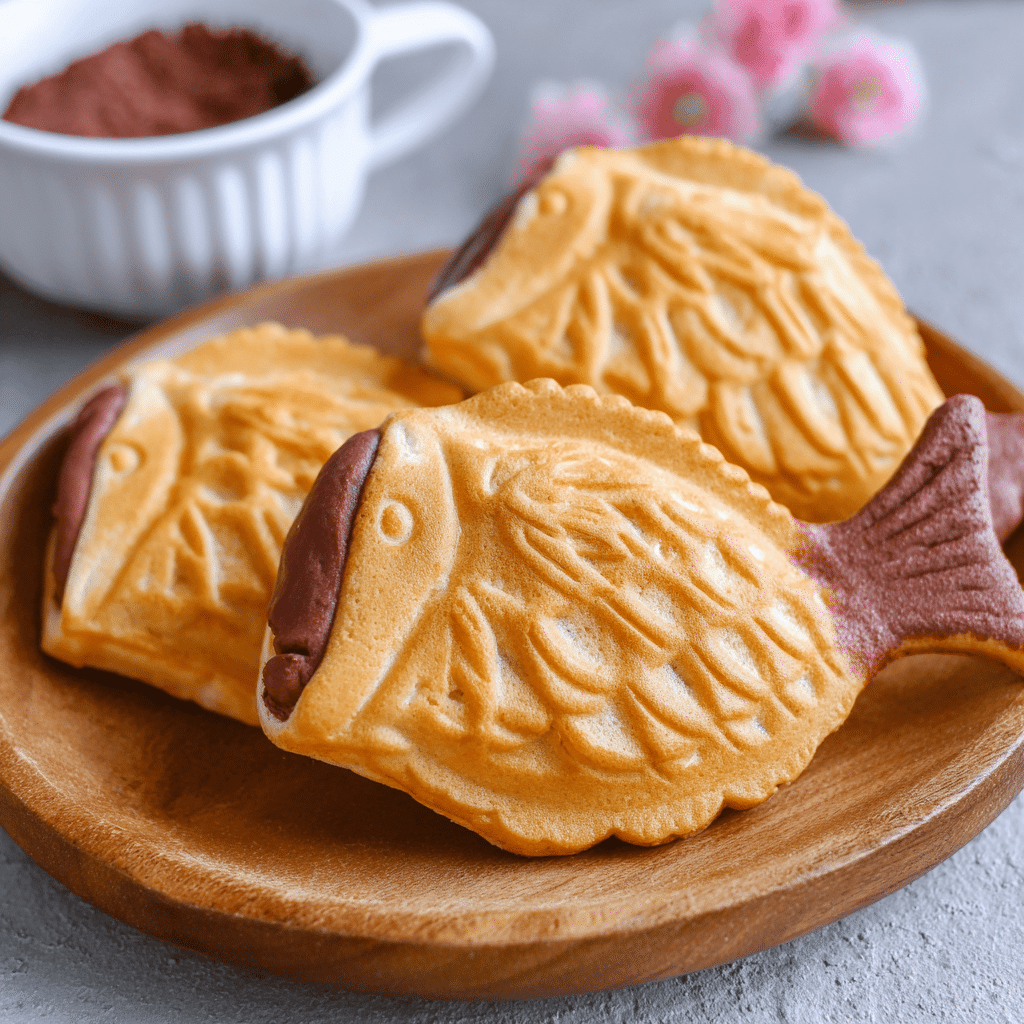The beloved Taiyaki is a staple of Japanese street food culture—an irresistible treat that’s as fun to make as it is to eat. Traditionally shaped like a fish, this charming pastry is filled with sweet red bean paste (anko) and cooked to a golden crisp in a specialized mold.
Its name literally means “baked sea bream,” symbolizing good luck in Japan. Whether enjoyed warm on a chilly afternoon or served as a unique dessert after dinner, Taiyaki offers a perfect balance of texture and sweetness. This recipe brings authentic Tokyo-style taiyaki into your kitchen with simple ingredients and detailed steps. Bake a batch for yourself or share the joy with friends and family—it’s a bite-sized taste of Japan that never fails to impress.
Full Recipe
Ingredients:
-
120g (1 cup) cake flour
-
1 tsp baking powder
-
1 tbsp sugar
-
1 egg
-
130ml (1/2 cup + 2 tbsp) milk
-
1/2 tsp vanilla extract
-
Neutral oil for greasing
-
200g (7 oz) sweet red bean paste (anko)
Directions:
-
In a mixing bowl, whisk together the cake flour, baking powder, and sugar.
-
In a separate bowl, beat the egg, then mix in the milk and vanilla extract.
-
Gradually combine the wet and dry ingredients to form a smooth batter.
-
Heat your taiyaki pan over medium heat and lightly grease both sides with neutral oil.
-
Pour a small amount of batter into one side of the pan, just enough to cover the mold.
-
Add about 1 tbsp of sweet red bean paste into the center of the batter.
-
Pour a little more batter over the paste to cover it completely.
-
Close the taiyaki pan and cook for about 2–3 minutes on each side, flipping occasionally, until both sides are golden brown and crisp.
-
Carefully remove the taiyaki and repeat until all batter is used.
Prep Time: 10 minutes | Cooking Time: 15 minutes | Total Time: 25 minutes
Kcal: 180 kcal per taiyaki | Servings: 4 servings
Introduction to Taiyaki: Japan’s Iconic Fish-Shaped Dessert
Taiyaki is one of Japan’s most beloved street food snacks—a charming, fish-shaped pastry traditionally filled with sweet red bean paste (anko). The name “taiyaki” literally means “baked sea bream,” referencing the “tai” (sea bream) fish, a symbol of good fortune and celebration in Japanese culture. While it may look whimsical, this dessert has a rich cultural significance and history, embodying Japan’s culinary artistry and attention to detail.
Originating in Tokyo over a century ago, taiyaki has since become a staple at festivals, food stalls, and specialty shops across the country. Its crisp, waffle-like outer shell and warm, sweet filling make it a delightful treat for all ages. Whether you’re a seasoned traveler who has tasted it fresh off a Tokyo street cart or a home baker trying it for the first time, taiyaki holds an irresistible charm.
The Cultural Roots and Evolution of Taiyaki
Taiyaki’s history dates back to 1909, when a Tokyo-based confectionery shop named Naniwaya invented it. Inspired by imagawayaki—another round, filled pancake—Naniwaya’s innovation was to mold the dessert in the shape of a sea bream. Sea bream is considered an auspicious fish in Japanese tradition, often served during special events like weddings and New Year’s celebrations.
The fish shape helped differentiate taiyaki from other sweets and quickly captured the hearts of the Japanese public. Over time, taiyaki spread from Tokyo to the rest of Japan, with regional variations emerging and filling types evolving to include custard, chocolate, cheese, and even savory ingredients like curry or sausage.
Today, taiyaki is not just a nostalgic snack; it’s a versatile treat that continues to evolve while staying rooted in tradition. It’s found in both classic street stalls and modern cafés, demonstrating its enduring popularity and adaptability.
The Symbolism Behind the Fish Shape
In Japan, the sea bream (“tai”) is more than just a fish—it represents celebration, happiness, and success. This symbolism is deeply embedded in Japanese cultural rituals and superstitions. The shape of the taiyaki is not random; it carries a wish for prosperity and good fortune.
The choice to mold this snack in the form of a sea bream helped taiyaki stand out in a crowded market of sweets and snacks. It also made the dessert instantly recognizable and memorable, helping it to become a cultural icon over the decades.
Today, the shape continues to delight children and adults alike, adding a playful, almost magical element to the eating experience. It’s also one of the reasons taiyaki is so photogenic—perfect for modern food culture and social media sharing.
Modern Variations and Fillings
While traditional taiyaki is filled with anko, the sweet paste made from azuki beans, modern versions have pushed culinary creativity to new levels. You’ll now find taiyaki filled with:
-
Custard cream
-
Chocolate ganache
-
Matcha (green tea) cream
-
Sweet potato paste
-
Ice cream (in open-faced versions)
Savory adaptations are also gaining traction, with fillings like cheese, curry, ham and egg, and sausage. Some shops even offer taiyaki with pizza toppings or kimchi fillings, showing how flexible the base recipe can be.
In Korea, a similar snack called bungeoppang (meaning “carp bread”) is often sold in the winter, and it has helped further popularize the concept of fish-shaped pastries across East Asia and beyond.
There are also taiyaki-inspired innovations like taiyaki ice cream cones, where the fish shape is used as a soft waffle cone, typically filled with matcha or vanilla soft-serve and colorful toppings. These reinterpretations show how taiyaki is constantly evolving to meet modern taste trends.
Specialty Taiyaki Shops and Their Unique Offerings
In Japan, some shops have elevated taiyaki into an art form. For example, Naniwaya, the original creator, still operates in Tokyo today and continues to serve their traditional version using the same recipe from 1909. These shops often cook taiyaki using individually molded iron pans rather than commercial batch machines, which results in a more artisanal finish—crispy, golden brown on the outside and beautifully tender inside.
Other specialty taiyaki shops focus on limited-edition flavors, seasonal fillings, and high-end ingredients like chestnut paste or black sesame. Some places even offer taiyaki made with matcha or cocoa batter, creating colorful and modern interpretations of the classic.
For visitors or locals, a visit to a taiyaki shop isn’t just about grabbing a snack—it’s an experience. The smell of the batter cooking, the sight of the fish molds steaming, and the warm treat in your hand—it’s a feast for all senses.
Taiyaki Around the World
Thanks to global food trends and the popularity of Japanese cuisine, taiyaki has made its way around the world. Cities with large Japanese communities or vibrant Asian food scenes—such as New York, Los Angeles, London, and Sydney—have embraced taiyaki in various forms.
Westernized versions often place emphasis on dessert fusion. For example, taiyaki ice cream cones have gone viral on social media, often filled with brightly colored soft-serve and topped with sprinkles, mochi, or fresh fruit. Some cafés pair taiyaki with coffee or bubble tea, turning them into a complete dessert experience.
This global spread has helped taiyaki transcend its cultural roots and become a symbol of playful, creative street food—without losing its identity.
Taiyaki at Home: A Trend Worth Trying
Making taiyaki at home has become increasingly accessible. With the rise of online recipes and the availability of taiyaki pans from global retailers, more people are discovering how easy and fun it is to make these treats in their own kitchens.
Home versions allow for endless experimentation. You can choose your batter style—traditional, pancake, or waffle—and customize the fillings based on what you like or what you have on hand. Whether you opt for the classic red bean or something more unexpected like Nutella or banana custard, the result is always a crowd-pleaser.
Taiyaki also makes a fantastic cooking project with kids. The fish molds and filling process are interactive and visually rewarding, making it a hands-on activity that leads to a delicious result.
Nutritional Insights and Serving Suggestions
While taiyaki is a dessert, it’s not overly indulgent when eaten in moderation. One taiyaki typically ranges between 150–200 calories depending on the size and filling. The anko filling is relatively low in fat and provides fiber and plant-based protein from the azuki beans.
For a lighter version, you can use less sugar in the batter or try fruit-based fillings like mashed bananas or unsweetened applesauce. On the other hand, if you’re making taiyaki as a dessert centerpiece, go bold with rich fillings like matcha cream or chocolate-hazelnut spread.
Taiyaki is best enjoyed warm, fresh off the pan, but you can also store leftovers and reheat them in an oven or air fryer to restore their crispy texture. Pair with green tea or iced matcha for a beautifully balanced snack or dessert experience.
Why Taiyaki Stands Out in a World of Desserts
Taiyaki combines cultural tradition, visual appeal, flavor versatility, and fun—all in one compact treat. Its nostalgic roots connect people to Japanese heritage, while its evolving forms keep it relevant in modern culinary circles. Unlike many desserts that focus solely on indulgence, taiyaki also invites a sense of craft, ritual, and storytelling.
Whether you enjoy it at a Tokyo festival, from a local food truck, or from your own kitchen, taiyaki delivers more than taste—it delivers experience.
Conclusion: A Delicious Symbol of Japanese Creativity
Taiyaki is far more than a fish-shaped snack—it’s a cultural artifact, a creative canvas, and a dessert that brings joy wherever it goes. Its delightful texture, charming shape, and customizable filling options have earned it a special place not only in Japanese cuisine but in the hearts of dessert lovers worldwide.
In an era where food must be Instagrammable, memorable, and delicious, taiyaki checks every box. From its humble beginnings in a Tokyo sweet shop to global foodie fame, taiyaki continues to evolve without losing its essence. Whether you’re a seasoned baker or just someone with a sweet tooth, taiyaki is one dessert you’ll want to revisit again and again.






